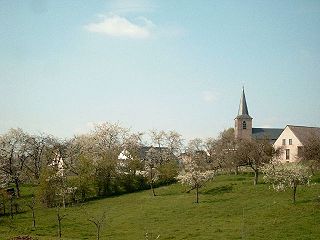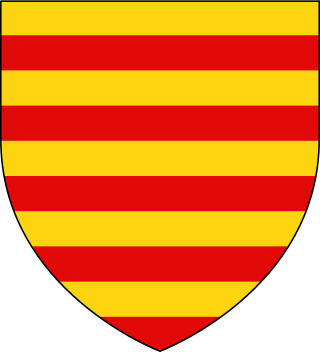Albert I the son of Robert I, was a count who held the castle of Namur and a county in the Lommegau. His county came to be referred to as the County of Namur in records during his lifetime.

The County of Loon was a county in the Holy Roman Empire, which corresponded approximately with the modern Belgian province of Limburg. It was named after the original seat of its count, Loon, which is today called Borgloon. During the middle ages the counts moved their court to a more central position in Kuringen, which today forms part of Hasselt, capital of the province.

The Hesbaye, or Haspengouw, is a traditional cultural and geophysical region in eastern Belgium. It is a loamy plateau region which forms a watershed between the Meuse and Scheldt drainage basins. It has been one of the main agricultural regions in what is now Belgium since before Roman times, and specifically named in records since the Middle Ages, when it was an important Frankish pagus or gau, called Hasbania in medieval Latin.
Giselbert van Loon is the first definitely known count of the County of Loon, a territory which, at least in later times, roughly corresponded to the modern Belgian province of Limburg, and generations later became a lordship directly under the Prince-bishopric of Liège. Very little is known about him except that he had two brothers, one of whom, Bishop Balderic II of Liège, is much better attested in historical records.

Louis I was the Count of Loon, now in modern Belgium, and Burgrave of Mainz, in Germany. He inherited these offices from his father. He also established the County of Rieneck apparently based upon the Burgrave's lands.
Rudolf or Rodolphe was a Lower Lotharingian noble born into a family with connections to Utrecht. He is thought by some modern interpreters to have later had lordships in the Hesbaye region, which is now in Belgium, in a part that mostly came to be incorporated into the later County of Loon. He was a son of Nevelung, Count of Betuwe, and a daughter of Reginar II, Count of Hainaut, whose name is not known. He had two uncles, one paternal and one maternal, who were both named Rudolf, and various proposals have been made about how the three Rudolfs correspond to various references to "Count Rudolf" in the 10th century "low countries." Although his paternal uncle Rudolf is sometimes considered to have become a cleric, Jongbloed (2006) argued that he must have been a count, and that he certainly had a wife and offspring. There is no contemporary record of young Rudolf, the nephew, as a count, nor indeed as an adult.
Otto is a purported Count of Loon and father of Count Giselbert, who would have been adult roughly around the years 980–1000. He appears in only one much later document that is considered unreliable, so his existence is doubted. The list of the counts of Loon is normally started with Giselbert.
Count Emmo, Immo or Emmon is one of the first known counts of Loon in the region of modern Belgian Limburg. Before him one more count is known with confidence, Count Giselbert, but it is not certain that Giselbert was Emmo's father. Verhelst for example has proposed that he was his uncle, and that Giselbert's brother Count Arnulf was father of Emmo and also a count of Loon.

Arnold II, Count of Loon, son of Arnold I, Count of Loon, and Agnes von Mainz, daughter of Gerhard I, Count of Rieneck, and Helwig von Bliescastel. He is distinguished from his father of the same name by historians who note records for counts named Arnold or Arnulf between 1179 and 1141. The first Arnold must have died between 1125 when Count Arnold appears in a record with his son also named Arnold, and 1135, when a new Count Arnold appears with his own son and successor Louis.
Count Gerard of Loon, was son and successor of Louis I, Count of Loon, and Agnes of Metz. He was count of Loon and of Rieneck. Because of a widespread misunderstanding concerning a document from 1101, some generations earlier, he is sometimes wrongly referred to as the second Gerard in this dynasty, "Gerard II".
The pagus or gau of Hasbania was a large early medieval territory in what is now eastern Belgium. It is now approximated by the modern French- and Dutch-speaking region called Hesbaye in French, or Haspengouw in Dutch — both being terms derived from the medieval one. Unlike many smaller pagi of the period, Hasbania apparently never corresponded to a single county. It already contained several in the 9th century. It is therefore described as a "Groẞgau", like the Pagus of Brabant, by modern German historians such as Ulrich Nonn.
Count Rudolf, was a count in Lower Lotharingia, who apparently held possessions in the Hesbaye region and in the area of Meuse river north of Maastricht. It has been proposed that he was a son of Reginar II, Count of Hainaut, and thus a member of the so-called Regnarid dynasty.
Count Emmo, Immo or Immon, was the name of at least one important Lotharingian nobleman in the 10th century, described by medieval annalists as a cunning strategist. Various life events of a nobleman of this name were recorded, although historians differ about exactly which records refer to the same person or people. The first record claimed for him shows him as a young noble granting land to a new vassal in the Condroz region in 934, a member of the entourage of Duke Gilbert of Lotharingia. During the revolt of Gilbert which ended at the Battle of Andernach in 939, he switched sides. After the revolt he was personally associated with the fort at Chèvremont, near Liège. It becomes difficult later in Immo's life to be sure that all records mentioning a count of this name are referring to the same person.
Werner, Count in Hesbaye was a Lower Lotharingian count in what is now Belgium and neighbouring parts of Germany. During this period the once independent Kingdom of Lotharingia, was coming under the control of the new Kingdom of Germany, but it was also still contested by the Kingdom of France.
The County of Duras was a medieval county with its seat at the castle of Duras. The 18th century version of this castle still stands and is a part of modern Sint-Truiden in the province of Belgian Limburg. The county was one of several counties in the Hesbaye region which covers the south of Belgian Limburg, and stretches into the neighbouring provinces. As a distinct entity under the name Duras the county only existed within the 12th century. After the first male line of counts died out, the county of Duras came by marriage to the Counts of Montaigu, whose other holdings were further south. Later they became part of the neighbouring County of Loon, which was ruled by cousins of the original counts of Duras.
Count Giselbert of Loon or (later) Duras, was the deputy advocate (subadvocatus) of Saint Trudo’s Abbey. He was son of Count Otto, the younger brother of Count Emmo of Loon. Giselbert was the first person to be named in contemporary documents as a count of Duras.
Hériman (Bovo) de Duras, son of Otto I, Count of Duras, and Oda, daughter of Giselbert I, Count of Duras. The children and grandchildren of Hériman were closely tied to the Cathedral of Our Lady and St. Lambert in Liege as well as the Counts of Chiny.
Count Otto of Duras was a count of Duras, and advocatus of the nearby abbey of St Truiden. Duras and St Truiden are in the modern province of Belgian Limburg. His parents were Count Giselbert of Duras and his wife Gertrud.
Baldrick II was bishop of Liège from 1008 to his death at Heerewaarden in what is now the Netherlands.
The Maasgau, Masao, or Maasland, was an early medieval region or pagus, on both sides of the Meuse, stretching north of the city of Maastricht.